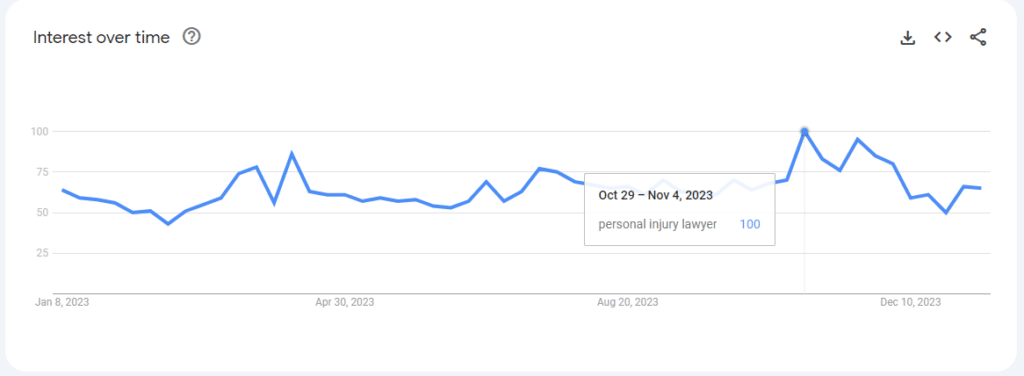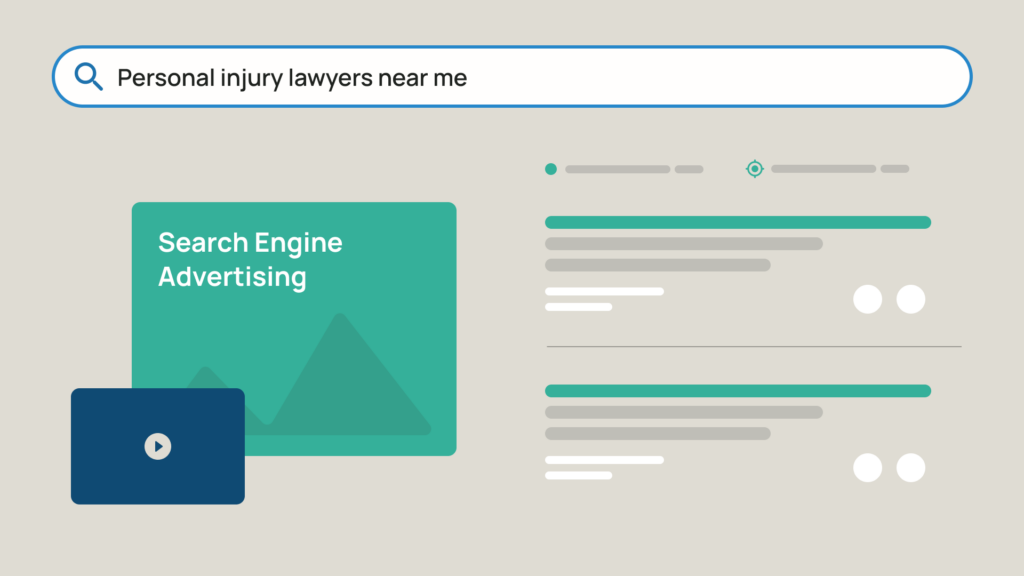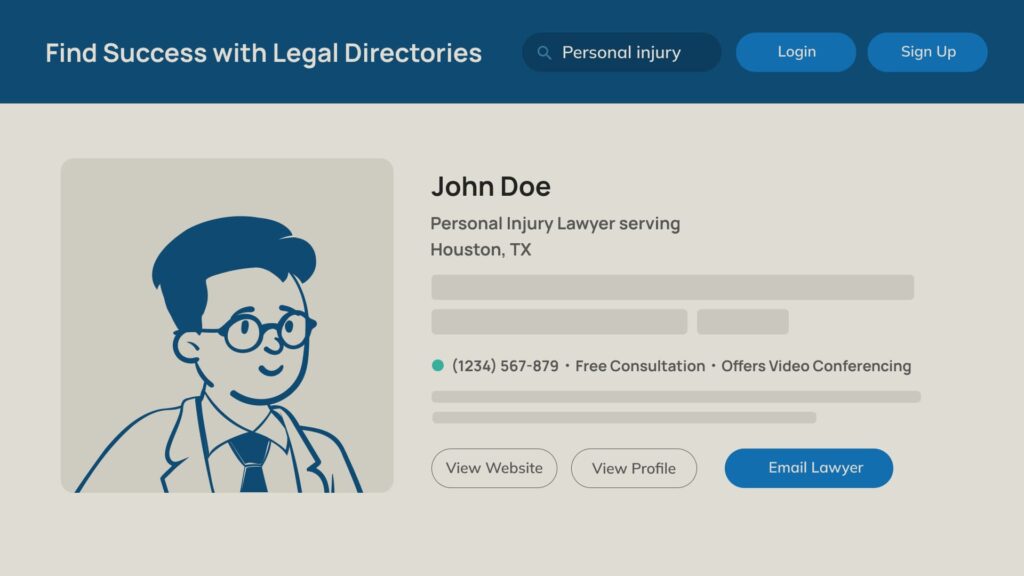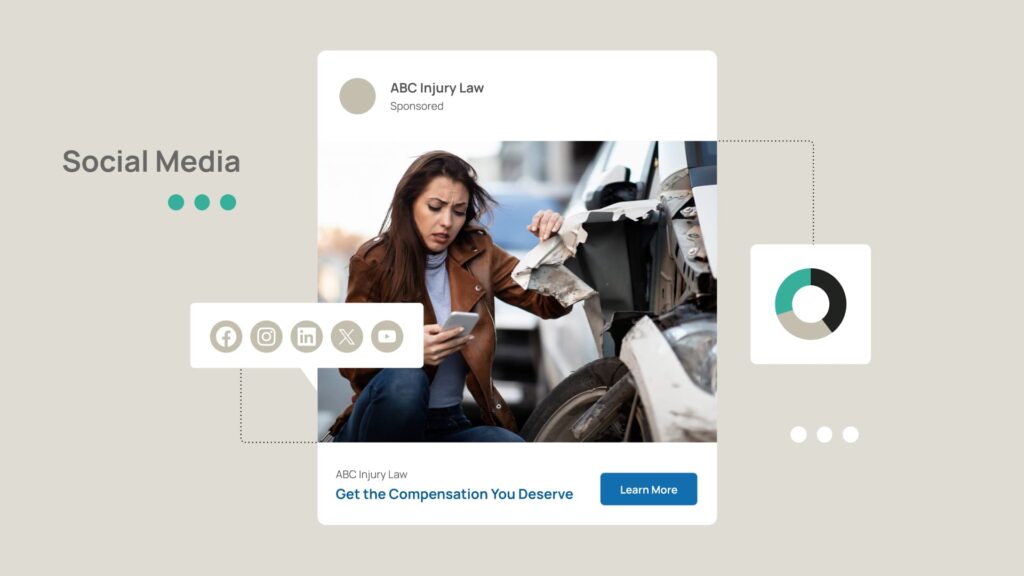To get qualified leads, you must invest heavily in personal injury marketing and personal injury lawyer advertising, because personal injury is an extremely competitive industry. In major cities, you can’t turn off the TV for 30 mins or walk down the street without seeing an ad for a personal injury lawyer. Personal Injury lawyers can’t afford to miss any opportunity to stand out in the crowd, including on the internet.
Whether you’re a solo practitioner or one of the “big boys”, digital marketing for personal injury lawyer are no longer the wave of the future; they’re the cresting swell of the present—an absolute requirement for any personal injury firm looking to compete in an ever evolving practice area. Just like legal technology has evolved from paper-based intakes to digital client intake, archaic software to cloud-based matter management software, Banker boxes to legal cloud storage, marketing too has gone digital.
While the list of reasons your firm should go digital could fill infinite Bankers Boxes, we won’t take up that much of your mental space— instead. We’ve put together the ultimate guide with personal injury marketing ideas and help you run a successful Digital advertising campaign, bringing qualified leads into your firm.
Contents
What is digital marketing?
Digital marketing, a.k.a internet marketing, is the process of promoting, advertising, and advocating a business and its product or services over digital media. This includes using tools that help drive website traffic, engagement, leads, revenue and ultimately promote personal injury lawyer seo.
Digital marketing is a very broad term that includes various marketing strategies: tactics such as content marketing, search advertising, search engine optimization, paid media, email marketing, and more.
Why should you use digital marketing for personal injury lawyers?
Digital marketing has become an increasingly popular strategy for businesses that are looking to target the modern audience and generate revenue, especially personal injury law firms.
Because, as of Jan 2024, there were 27,100 monthly searches for Car Accident Lawyers in the US (by the way, how many of these queries did you get?). If you need a hyperlocal number, there were 1000 searches for “Car Accident Lawyer” in Houston, Texas.
Let’s take a look at search interest in “personal injury lawyer” on google over 12 months.

Source: Google Trends
If you, as a personal injury lawyer, want to generate leads for your practice, then you need to craft your online presence on Google and other media channels like social media, law directories, etc., so that when prospects search for a lawyer, they find you.
As far as digital is concerned, here are a few personal injury lawyers marketing ideas that you can use to generate leads for your personal injury practice.
How to market a personal injury law firm and generate qualified leads with search engine advertising
Google search ads is a paid advertising platform that falls under the marketing channel known as pay-per-click (PPC).
PPC Marketing is where you pay per click on an ad. It allows you to build a PPC campaign in the search results of Google. When running a PPC marketing campaign for a personal injury lawyer, you can pick the keywords that are relevant to your practice and trigger relevant search ads every time someone searches for the keyword from your list.
For example: if you pick “Bronx car accident lawyers” as a keyword. our ads will be shown when someone types the word “Bronx car accident lawyers” into Google.
Here we highlight essential aspects you should consider before starting search ad campaigns:
Decide your targeting before personal injury lawyer advertising
The more focused your paid search campaigns are, the more clicks you generate —leading to more leads and more clients. This is why Google search ads have become increasingly popular in the legal industry.
The thing about Google is that it lets you build a highly targeted campaign based on your personal injury attorney marketing strategy. You can target your audience based on demographics (age, gender, etc.), geographic location (country, state, city, county, etc.), device (devices such as mobile, desktop, tablet, etc.), and various other targeting options.
Just as an example – you may want to target people above the age of 25 years in Houston and bid higher for the ones who use a mobile device to search for a lawyer.
You may want to stick to the basics first because it is easy to get lost in all the various targeting options that Google gives you. And preferably go manual targeting instead of letting Google decide the targeting for you.
Do your keyword research
You should do your research on ‘Keywords’ before starting search ads..The success of your campaign depends on your ability to identify keywords with relevance and intent that match what your target audience uses when they search for your business online.
To begin with, narrow down your research and find an answer to the specific questions like What are the keywords you think are going to drive better results? Eg. “Personal injury lawyers” or “car accident lawyers in Houston.”
Those searching for a “Personal injury lawyer” might be in research mode, whilst someone searching for “car accident lawyers in Houston” might be looking to make the decision right now. Google’s keyword tool is the right place to start digging for answers.
Budget and bidding
You must first decide the objective of your campaign that suits your overall personal injury lawyer advertising strategy. For example, to begin with, you may just want to focus on getting more clicks. You should only go for the “maximizing clicks” objective.
If you want to focus more on customer acquisition, then you should go for the “Target Cost per Acquisition” bidding strategy.
If you are willing to spend the time optimizing and wish to have maximum control over the campaign, you can stick to “Manual CPC bidding”, this bidding takes effort and research but can drive maximum results.
So, how does this work? Someone types something into the Google Search box. This is known as a ‘query,’ and for every query, you land on the result page. The page starts with certain ads that are closely related to your query. Generally, there are 3 to 4 ads, below it are the ‘organic results’ (more on it later), and then again a few ads at the bottom of the page.
How does Google decide how to rank these ads? Well, it has many parameters, including keywords, ad relevance, and the amount you are willing to pay for every click, but for now, we’ll explain one of the most important aspects
Google Search works using an auction mechanism, the price of which is based on who is willing to pay most for higher ranking ads. The Google keyword tool provides you with the estimated cost per click for each of these categories. Based on these estimates, you can calculate how much your competition is paying for the clicks. You can also use SEMrush to get these insights.

Source: Google Ads
The keywords related to personal injury are highly competitive and therefore have a high cost per click.
Real-time insights and optimization
Once you decide on your budget, keywords, and your campaign structure, it is time to measure and evaluate the performance of your campaign. Based on the objective you selected in the campaign, you have to monitor KPIs such as (but not exclusively) no. of clicks, conversion rates, impressions, and click-through rate.
An important factor here is your “Quality Score”, you should focus on creating and testing various ads copies for a set of keywords, then measure which ads perform better. Well optimized ad copies with higher ad relevance will always give you the best return on your investment and reduce your cost per click.
You should also monitor the “Bounce Rates”, “Time Spent”, and “Avg. Session Duration” on your landing page connected to the search ads; these metrics give you insights into the landing page experience and help you improve it.

Get more personal injury clients with legal directories
It may be easy for your friends to find you on Facebook. But is it easy for a plaintiff to find you on the internet without knowing your name? Personal Injury attorneys are always either busy preparing for cases so that they can get their clients a settlement that they deserve, or on the look-out for new cases.
You already know that there are 60,500 searches for car accident lawyers on Google every month. Based on the above data, there are three things you can do to grow your lead pipeline.
- Optimize your legal website for search engines for Google to tap these searchers. SEO is time-consuming and a long-term strategy.
- Advertise on Google Search (which is the CPC model) targeting these keywords. However, in the United States, it can cost a personal injury attorney $140 every time someone searches and clicks on the ad for the keyword “Personal Injury Lawyer near me.”
- You can leverage personal injury legal directories that already rank for these keywords by posting your profile there, which is FREE on almost all the leading directories.
Someone with a huge budget for marketing for personal injury lawyers and patience could do all three. However, for someone who wants to get steady and adequate case inquiries faster, especially solo attorneys and small law firms, the third option could be perfect.
If you are reading this article, then chances are you already have a profile on at least one personal injury legal directory or attorney referral network, and so do your competitors.
Remember, the more websites you are present on, the more the chances of being visible to your prospective clients. Also, the more relevant information you share, the more you increase your chances of showing up on a search and being connected to potential clients.
However, to get more personal injury clients, you need to stand out from the competition in the crowded legal directories space and convince your potential clients that you are the right fit for their case. But, how to do this, you ask?
Here is how to boost your profile on legal directories and stand out from the crowd:
Having a well-optimized profile can increase your visibility on directories, resulting in more clicks and more leads. Also, it can help you build your brand. So you should focus on the following elements of your profile and make sure these basic blocks are in order.
Your Profile Picture
Invest in getting yourself a high-quality, professional headshot. Upload the picture in the exact dimension a law directory recommends. Also, name the image using your name and law firm name. Because Google indexes these and can show it as a result whenever someone searches your name.
The headline
Remember three pillars of any marketing channel – Attract, Convince, and Convert. Your headline helps you grab the attention of potential clients on these directories and is an essential part of your profile.
Instead of making the headline about yourself, make it about your potential client. Include the keyword that the plaintiff searches the most in the headline if the word limit allows you.
Keep it short, clear, and creative. Hire a copywriter if you struggle to come up with one. If you don’t know a good copywriter, then don’t worry; there are many websites where you can find copywriters within the range you’re willing to pay, such as Upwork or Fiverr.
About you
Here, you focus on convincing potential clients. So keep this section brief and interesting, pay attention to a keyword (include the keywords that users are searching for). Some directories’ “About Me” sections allow you to use photos, rich media (videos, interactive maps, etc.), links, etc… So take advantage of these features so your audience knows who you are and what it would be like to work with you.
- Include years of experience, skills, education, personal injury practice areas, credentials, and awards you received. Keep it relevant to your audience.
- Most importantly, talk about the cases you have worked on recently. You don’t have to include all the cases, just a few high-impact, high personal injury claim value cases.
- We observed that most lawyers don’t update their profile; therefore, they lose their profile search rank. Update the cases you’ve won, credentials, and awards every 3-4 months.
Upload videos
Video is worth a thousand pictures; there is nothing that can be more convincing than a brand video. Invest in producing a professional video as it is a perfect medium to set yourself aside from the rest of the pack, again, websites like Upwork and Fiverr can come to your rescue here.
The video should tell a story, so instead of creating it about your law firm, make it about your clients. Introduce your potential clients with your past clients and let them talk about how you helped them or their loved ones get the justice they deserved and win the personal injury claim.
Client testimonials add a human element to your services and help demonstrate the effectiveness of your work.
- Include your name or your law firms name, and practice area, in the title of the video
- Embed the video from YouTube so that you track the views and other analytics to gain insights.
- Make the thumbnail of the video engaging; try not to keep it blank.
- Include the ways to get in touch with you like phone number, address, and email.
Reviews
We cannot overemphasize the importance of reviews. By sharing reviews, you convert potential clients into a lead. Ask your previous clients to leave a helpful review on these directories. The higher your number of reviews, the higher your chances of ranking above your competition.
Ask your clients to keep the reviews short instead of making it a story; request them to send you a copy before they post it online.
Accurate ways to reach you
Once a potential client decides to contact you, you must have the correct information so they can easily reach you. Incorrect contact information can result in a lost opportunity. It’s unlikely that your potential client will look up the right information elsewhere.
Having accurate contact information helps your broader online footprint, making it easier to find you when they search online. Include contact information such as email, phone, website, and location of all your branches, including Google Maps… Provide your social media handles, including Twitter, LinkedIn, Facebook, etc., so they can look you up, which will help them establish trust.

Remain at the top of your audience mind with personal injury social media marketing
Social media impacts almost every aspect of our daily lives – work, politics, breaking news, and more. It’s used globally by companies and consumers – and is one of the most effective channels to connect with your target audience.
Because of its rapid adaptation in modern culture, social media marketing has become a global
phenomenon and an influential part of the marketing strategy for almost every brand and business around the world.
A report from We Are Social says that there are 3.196 billion users active on social media networks, which is 42% of the global population. Moreover, the average American spends approx. 2 hours per day on social media, according to the same report citing the Global Web Index.
As a Personal Injury lawyer, there are many things you have to do to keep and get new business. One thing you cannot ignore is Social Media marketing for law firms. Whether or not you are part of the conversation, it’s critical to participate and engage in a meaningful way.
Social Media today is used for various reasons: connected to your family and friends, building your network, staying up-to-date with what’s happening in the world, and researching just about anything, i.e., a holiday, new product or personal injury lawyer. According to another Global Web Index report, 42% of people use social media for researching businesses.
Thus keeping all this in mind, let’s outline a few things that will help your personal injury law firm have an impactful social media presence and a robust digital marketing strategy:
Know your goals
It’s essential to chalk down what you want to accomplish with social media before investing your time on social media networks.
It could be that you want to attract more clients, build awareness about you or your firm locally, drive people to your website to learn more about your firm, or it could be all of them. You should set up social media dashboards like Hootsuite.
Monitor search terms, hashtags, and topics that your potential clients are talking about. For example – You may want to know when someone asks a question about an injury due to a dog bite and the claims process; you can do this by following #dogbite or #Harzardousworkplace in your city.
Be seen
Leading social media networks like LinkedIn, Twitter, and Facebook work on algorithms that typically reward posts or pages (for LinkedIn and Facebook) based on the amount of engagement; it can be alike,
share, or comments about the post or page.
To be seen amongst the clutter of posts and information, the content must be current, compelling, and engaging. Then it becomes a cycle when you post something that gets likes and comments that reach out to more and more audiences increasing the chances of more interaction.
Then, of course, you see the analytics to measure the success of each post and your online presence as a whole.
Visual content
They say a picture is worth a thousand words, but on social media, it is worth far more. Most social media networks have word limits, so there is only so much you can communicate via text – but images and videos can give you a chance to overcome those limitations by communicating visually.
Social media posts with images, videos, or GIFs tend to get more engagement than text posts. All social media networks have evolved into visual-first platforms.
Facebook encourages video posts and ads, Twitter allows users to upload multiple images, and it has stopped counting media URLs against the character limit. You don’t have to always get a photoshoot or a graphic designer to create high-quality photos and videos; you can use websites like Shutterstock for stock photographs, illustrations, and videos.
Being a personal injury lawyer, you can post images and videos educating people about steps potential claimants should take if they are in an accident, how to prevent accidents, how the legal process works, etc. Informative content that helps them in the event of distress.
Law firm page
Social media networks like Facebook and LinkedIn help your law firm build awareness, share updates, and strengthen social media marketing for your law firm. You can use Facebook and LinkedIn to choose the type of page you want to create.
It will allow you to prominently display key snapshots of your law firm, highlight activities and your law firm’s milestones, publish results of cases you win for your clients, their stories, and more. Create a calendar of the social media posts that you want to publish at least 30 days in advance, it will help you come up with ideas well in advance instead of scrambling for posts on time.
The timeline offers more branding and lead gen options; the large cover image has plenty of real estate for your branding, images, and call to action so you can get the attention of your potential clients and get them to your page.
Especially on Facebook, comments made on your company page will appear on users’ timelines, shared with their friends. “Likes” will also appear on their page, keeping your firm in their minds.
Facebook lists
The Facebook list allows you to organize a list of different topics, influencers, clients, and prospects you may want to follow. It means that you can target a specific segment of your audience by delivering posts to a particular group.
You can also track the analytics of each group of people. So you can measure if a particular group of people is interacting less than another group.
Boost a post
Start small, let’s say $50 for one of your popular posts, preferably one that links to an action-oriented, information-packed landing page; it could be a blog post too. When we say, action-oriented people should provide you their email id, or other contact details that can become a lead you can nurture.
Facebook, Twitter, and Linkedin make it super easy to do. After you publish a post, simply click the Boost Post button and follow the instructions to customize your target audience, spend, and duration. There are the following ways to choose your audience:
- People who like or follow your page
- People who like your page and their friends
- People you choose through targeting by location, age, gender, interest, and behavior. You can go pretty deep here.
Of course, targeting differs from channel to channel, but you can target the audience you think is a perfect fit.
Tools
Just like legal technology makes lives simpler for personal injury lawyers; similarly, there are many social media management platforms to manage your different social media platforms easily. Tools like Hootsuite and Sprout Social let you monitor social media posts by keywords, hashtags, and more. It also helps you schedule and posts content on multiple social media accounts, all from one dashboard.
Tools like Feedly are an excellent way to categorize the content you want to keep an eye on, and it helps you to know what niche influencers are talking about, so you stay on top of the trends.
Test and optimize
All the social media platforms will give you access to analytics, showing how your post is driving engagement.
They provide you with valuable, actionable data and show exactly what is working on every post you publish. This data includes the number of impressions, reach, engagement, clicks (if you are directing them to a blog or a landing page), and the geographic and demographic data of your audience who engage with your post. Experiment with your posts, post at a different time of the day, change the call to action, modify, copy, images, and more, to figure out what exactly drives the most engagement.

Best practices to lead generation for your personal injury law firm
Law school prepares attorneys to think, act, research, and write like an attorney, but once you have your law license and work at a firm, you must also take on additional roles. Marketing strategist is one such role. A proper marketing plan can propel your firm forward, fostering growth and strengthening your reputation among clients and colleagues.
It is essential to take inventory of your marketing strategies and develop new ones. In this section, the CloudLex team helps you with your journey by providing best practices to lead generation.
CloudLex is helping attorneys serve their clients and maximize their business’s growth by providing case management software tailored to personal injury firms’ needs.
Create a content strategy
As the saying goes, in marketing, “Content is king.” In broad terms, content refers to materials that your firm publishes for personal injury marketing purposes. For example, you may have a blog on your website or send a newsletter to clients or subscribers. Also included in the realm of content are practice area pages that describe what your firm does, informational videos, and social media marketing.
Creating a content strategy enables you to publish material to increase engagement and bring in more clients intentionally. Rather than spending copious amounts of time and money posting anything and everything you can think of, it can pay off in spades if you consider your target audience and the effectiveness of your efforts.
In the competitive world of personal injury law, standing out from the crowd can feel like sprinting uphill. While case management and client service are crucial, building a strong online presence is another key factor in attracting and engaging potential clients. This is where content marketing, particularly blogging, shines.
Why Blog? The Benefits Speak for Themselves:
- Traffic Magnet: Blogs draw people to your website, potentially turning them into leads. SEO optimization further boosts your visibility in search results when people seek personal injury services.
- Authority Amplifier: High-quality blog content positions you as a thought leader, building trust and establishing your firm as a reliable resource.
- Client Rapport Builder: Blogs allow you to connect with potential clients on a personal level, addressing their concerns and demonstrating your expertise.
- Lead Generation Powerhouse: Informative and engaging content encourages readers to reach out for consultations, turning curious clicks into valuable leads.
Now, let’s dive into 5 specific blog ideas that will spark your creativity and ignite your firm’s growth:
1. Highlighting attorney experience:
Individual Attorney Pages: Dedicate sections on your website to each attorney, showcasing their:
- Educational Background: Highlight prestigious universities, scholarships, or specific legal disciplines they mastered.
- Professional Journey: Tell a compelling narrative of their career path, emphasizing past firms, notable cases, or pro bono work.
- Awards and Recognition: Feature bar association accolades, awards from legal organizations, or recognition by peer-review publications.
- Personal Interests and Hobbies: Humanize your attorneys by sharing their passions outside of law, fostering connection with potential clients who share similar interests.
Attorney Blog Series: Assign each attorney a specific topic based on their expertise. For example, a medical malpractice attorney can delve into complex medical terminology, while a car accident specialist can analyze specific traffic laws.
“Ask Me Anything” Sessions: Choose platforms like Facebook Live, Reddit AMAs, or your website’s blog comment section to host Q&A sessions with individual attorneys. Promote these sessions beforehand on social media and announce the topics to attract relevant audiences.
Testimonials and Case Studies: Feature written or video testimonials from past clients highlighting their positive experiences with specific attorneys. Additionally, create anonymized case studies showcasing successful outcomes your attorneys achieved for past clients with similar injuries.
2. Thinking local:
Partner with Local News Outlets: Pitch safety tip segments or informative articles to local news channels, radio stations, or newspapers. Highlight seasonal hazards, specific accident-prone areas, or legal updates relevant to your community.
Organize Free Safety Workshops: Collaborate with community centers, libraries, or senior citizen centers to host free workshops on topics like slip and fall prevention, pedestrian safety, or first responder procedures after car accidents. These workshops allow direct interaction with potential clients and showcase your expertise.
Analyze Local Legislation: Monitor recent changes in state or local laws impacting personal injury claims. Create comprehensive blog posts or infographics explaining these changes and their potential implications for injured individuals in your area. This positions you as a trusted resource and demonstrates your knowledge of the evolving legal landscape.
3. Answering the unspoken:
Keyword Research Tools: Utilize tools like Google Keyword Planner, Ahrefs, or SEMrush to identify high-volume search queries related to personal injury law in your local area. Analyze the intent behind these queries based on Google’s “search intent categories” (informational, navigational, transactional, commercial) and craft content that directly addresses each category.
“Myth Buster” Blog Series: Dedicate a blog series to dispelling common misconceptions surrounding personal injury claims. Address myths like “I need a witness to file a lawsuit,” “I can’t sue my employer if I get hurt at work,” or “Insurance companies always settle out of court.” Provide clear explanations and legal references to debunk these myths and establish your credibility.
Step-by-Step Guides: Develop actionable guides on navigating the personal injury claims process in your state. Cover steps like filing an initial report, choosing the right attorney, gathering evidence, and negotiating with insurance companies. Offer these guides as downloadable PDFs or interactive webpages for easy access.
4. Google autocomplete magic:
Long-Tail Keywords: Explore longer, more specific phrases suggested by Google autocomplete when you type in broad terms like “personal injury lawyer.” For example, target queries like “best personal injury lawyer for car accidents in [your city]” or “slip and fall injury lawyer free consultation.” These reveal user intent more clearly and lead to unique blog topics.
Topic Clusters: Identify related autocomplete suggestions and group them into clusters based on a central theme. Create comprehensive blog posts that address each cluster’s theme, covering several related keywords. This approach provides a holistic understanding of the topic and improves your search engine visibility.
Trending Topics Monitor: Use Google Trends to identify trending topics related to personal injury law in your local area or nationally. Create timely blog posts addressing these trends to capitalize on current interest and attract new readers.
5. Tech-savvy lawyer persona:
Showcase Your Tech Stack: Feature blog posts or website sections dedicated to the technology you utilize to enhance client experience. Explain how secure online portals, remote video consultations, legal research tools, or cloud-based document management systems benefit your clients.
Embrace Social Media: Actively engage on platforms like Twitter, LinkedIn, and Facebook. Share legal insights, industry news, behind-the-scenes glimpses into your firm’s culture, or even humorous legal memes. This humanizes your brand and attracts tech-savvy audiences.
Invest in Website Security: Ensure your website is secure with the latest encryption protocols and regularly updated security plugins. Offer mobile-friendly design and intuitive navigation for seamless user experience on any device.
Bonus Tips:
Collaborate with other professionals: Partner with doctors, chiropractors, or physical therapists to co-create informative blog posts. This expands your reach and offers valuable insights from different perspectives.
Run contests and giveaways: Host social media contests or offer free consultations to incentivize audience engagement and attract new leads.
Track your results: Use analytics tools to track your blog’s performance, identify what resonates with your audience, and adapt your content strategy accordingly.
Use an analytics report and dashboard
Utilize an analytics report and dashboard for your website, social media platforms, and law firm to understand how (and if) your efforts work together to attract and keep more quality clients. Set goals for your firm or individual team members and track those over time to see if you are progressing. Set weekly, monthly, quarterly, and annual review periods to ensure your marketing budget does not become a runaway train with no way to scale it back quickly.
Case management software providers like CloudLex allow you to generate customizable reports through an legal practice analytics dashboard. You can view vital performance markers by case type, client, team member, and time period to ensure you see the data you need to set and meet your goals.
Learn about your clients
Understanding who your clients are and what they are looking for can be beneficial to ensure that you are meeting them where they are with the information they need at that point. Being as specific as possible with who your ideal client is can do wonders in helping you curate a marketing campaign that speaks to them.
Using effective intake software can help you gather critical data about your clients, not just for that specific matter but to develop an overall targeted law firm marketing strategy. Additionally, this data can help you determine if your existing plan is on track. Case management software provider CloudLex has a unique and intuitive Client Intake Management Software to help you gather all the information you need to run and grow your practice.
Leverage the power of web forms and chatbots
Finally, web forms and chatbots are two powerful web personal injury marketing tools. Often, clients search for an attorney online and peruse multiple attorneys’ websites before they ultimately reach out to schedule a consultation.
Chatbots can perform outreach to visitors on your firm’s website to help them feel seen and valued while increasing the chance that they will contact your office. Likewise, web forms allow potential clients to easily engage with your firm without picking up the phone. Both methods are also incredibly useful ways to gather contact information about web visitors and prospective clients without requiring your staff to do anything beyond setting up the service.
Conclusion
Sustainable Personal Injury marketing depends on how many strategic lead generation sources you build. Some sources will give you brand awareness, and some will give you qualified leads.
PPC advertising can be one of your best digital marketing channels irrespective of marketing objective, but only if it is done right and optimized on a daily basis to ensure you get maximum ROI from your advertising dollars. Focusing on legal directories as well as SEO will give its due return in time.
Converting social media presence into a lead generation machine takes time and discipline. Still, by following social media practices, you will be an accomplished social media marketer in no time – the success over social media will translate into your offline business development and your law practice health as well.
Creating a content strategy, utilizing analytics reports and dashboards, and learning about clients are important personal injury law firm marketing best practices to generate leads.
At least, you will build meaningful relationships with other individuals who might need your help for themselves or their loved ones.
Disclaimer:All product names, logos, and brands are the property of their respective owners. All company, product, and service names used in this document are for identification purposes only. The use of these names, logos, and brands does not imply endorsement. We disclaim proprietary interest in the marks and names of others. Any views expressed in this document represent the beliefs and opinions of CloudLex, whose analysis is based solely on publicly available information. No representation or warranty, express or implied, is made as to the accuracy or completeness of any information contained herein. CloudLex expressly disclaims any and all liability based, in whole or in part, on such information, any errors therein or omissions therefrom. CloudLex also reserves the right to modify or change its views or conclusions at any time in the future without notice.

